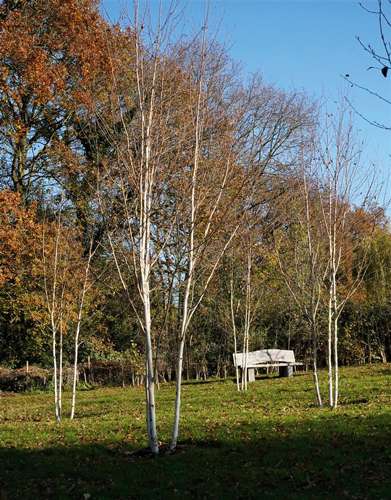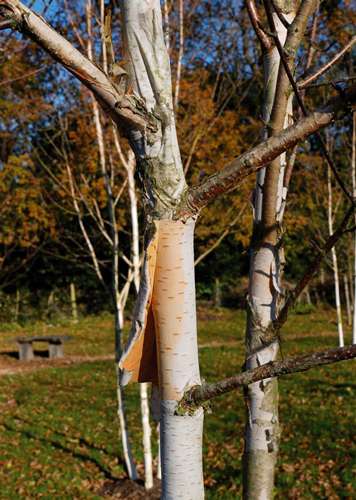
A sunny January morning can be the best time of all for seeing trees. Once the leaves have fallen, the individual shape of each tree is visible – and the different kinds of bark add to the attraction.
Bark protects the trees’ essential living systems from temperature extremes, storms, attacks from diseases, animals and insects. What I didn’t know was that bark can also photosynthesize i.e. convert the raw materials of water and carbon dioxide to sugar and oxygen – using the energy from the sun. Deciduous trees are more likely to have photosynthetic bark – and they quietly tick over during the winter, without the need of their leaves.
And an example is the silver birch. A slender, elegant tree which can light up a wood with its pale trunk. It was the first tree to move northwards after the last glaciations, the pioneer of our native species. It is one of a number of trees which shed their bark – and is much planted as an ornamental, particularly the North American ‘paper birch’ betula papyrifera. The poet John Clare (1793-1864) used it as a substitute for paper; he was poor and paper was expensive. I found a nice piece of birch bark and thought I would do as John Clare did. The bark took the ink very well – but I wonder what he did to stop it curling at the edges? Should one pull the lose strips of bark off? No. The bark should be allowed to fall off on its own otherwise the inner bark and living tissues can be damaged. The fashion for scrubbing at the stems of birch makes them look like legs in NHS surgical stockings.
The London Plane is also a bark photosynthesizer and it keeps its trunk active by shedding old bark in scales. This tree is much used as a city street tree and prized because it is seen to ‘clean itself’ of soot and other pollution.
I recently saw an aerial photo of Cranleigh taken in 1953. It was possible, looking at that densely wooded view to imagine what this area was like when it was part of the Wealden forest of Andradswald. The soil is poor for agriculture and the forest, other than minor incursions remained thick and mysterious; a hideout for the lawless. But the change was noted in 1664 by John Evelyn who declared that it was a glass blowing and charcoal industries which were causing the loss of woodland. In 1774 – on his journeys round the South, Daniel Defoe listened to people telling him that the great forest was disappearing because of the oak felling for timber to build the Navy’s ships. He decided that both Evelyn’s explanation and the Navy’s need were ‘groundless’ and that the forest was a large enough. He was wrong – as after 1774 the Navy and the merchant fleet doubled in number of ships in 40 years –and the shrinking of the forest was widely noted. An aerial photograph of Cranleigh taken now would show that the threat to the last remaining patches of woodland has been urbanization.
Oliver Rackham, who died in 2015 was widely recognised as an authority on the countryside and its history. His celebrated book The History of the Countryside has just been re-issued. He wrote about ‘reading’ a landscape – looking for clues in the scattered remains of how things once were. He was first and foremost an expert on woodlands, and his views on conservation are interesting, as they chime with a growing body of critics which argue that conservation is better served by allowing native species to seed and old wood to regenerate. It is nice to think that planting trees will save the planet – but the situation is a little more complex.
His book is wide ranging and his prose invigorating – for poetic nature writing, read instead Robert MacFarlane or Richard Mabey. Rackham writes about the loss of native flora and fauna; like the cranes which once lived round here and gave our village their name. Also what he calls ‘exotic introductions’ – particularly in the 18th century when the shooting people were beginning to run out of native species to kill for sport. That’s probably why we have the grey squirrel.
You might be interested in his explanation for holloways – there are many in this area. Even more interesting, if you have ever wondered why there are remains of moats round here – like the one right in the centre of Cranleigh – Rackham is your man!
Winter walks are a perfect opportunity to really look at the clues from the past which are still there to be spotted, once you know what you are looking at.
Happy New Year.












